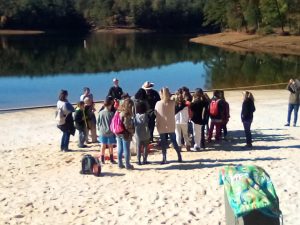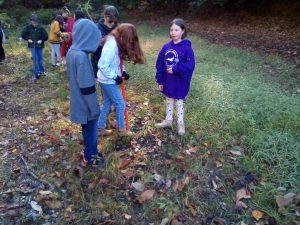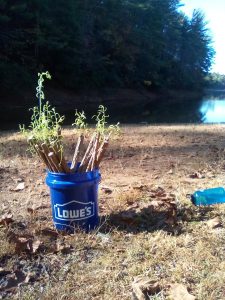Fourth grade students from Martinsville City and Franklin County schools planted trees along Philpott Lake while learning about the importance of taking care of the environment.

The Streamside Trees in the Classroom (STIC) program aims to teach children the importance of the environment in a way that is relevant to what they are learning in the classroom. The program has been in operation for 10 years. This year alone, students planted more than 150 trees.
Krista Hodges, education manager for the Dan River Basin Association (DRBA), said the program helps teach children a wide variety of topics.
“We partner to offer this to fourth grade students because it aligns well with what they’re learning in the classroom based around watersheds, water quality, riparian buffers,” she said.

Participating students visit stations to learn about conservation, erosion, water quality, life cycles, riparian buffers, water safety, and more, she said.
Stations are manned by DRBA partners, including Blue Ridge Soil and Water Conservation District, U.S. Department of Agriculture, Department of Forestry, DRBA, the Reynolds Homestead, Patrick County Master Gardeners and the U.S. Army Corps of Engineers.
The program also goes hand in hand with federal program Every Kid Outdoors, or EKO, which provides free day passes to federal recreation facilities for fourth grade students.
“I was counting just over 400 students participating in the program. So, that’s really good coming back from the pandemic and having that many students,” Hodges said.
The trees planted were Black Willows, which are native and grow quickly. Black Willow trees also thrive around streams.
“All of the trees are planted along a stream or a lake that is in need of restoration, so anywhere that you can plant a tree along a waterway is definitely helpful,” Hodges said.

Dillon Brown, with the U.S. Army Corps of Engineers which manages Philpott Lake, said “we’re happy to host this at Philpott Lake. It lines up great with both our initiatives, them being community outreach and us being community outreach as well, but also environmental education. We’re just glad we can partner with this and make this happen.”
The impacts of the program are evident all around, but especially in the children who participate.
“For some of these kids, it may be the first time they’ve ever planted anything. Just to be able to get outdoors into the forest, into somewhere that’s somewhat wild, if you will. To be able to play and interact with that kind of stuff, it’s good for a lot of kids who may not get to do that very much,” Brown said.
There is also a slight environmental impact.
“As far as environmental impacts, the survival rate is not bad. It does make a difference, though, because it helps regenerate better than it’s regenerating on its own,” Brown said.
Hodges added the trip was many of the children’s first field trip in years due to the COVID pandemic.
“For most of them, this is the first field trip they’ve been on since they were in first grade,” she said.




